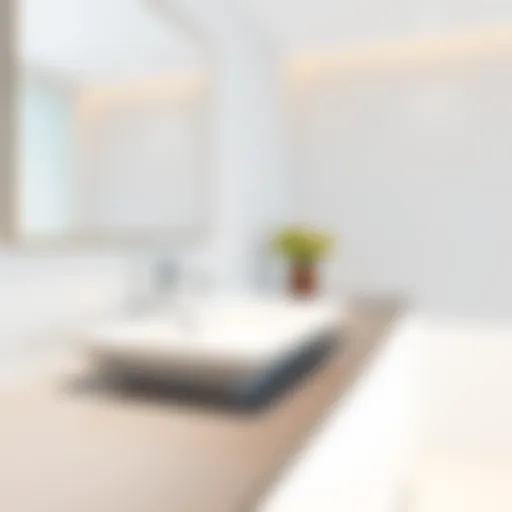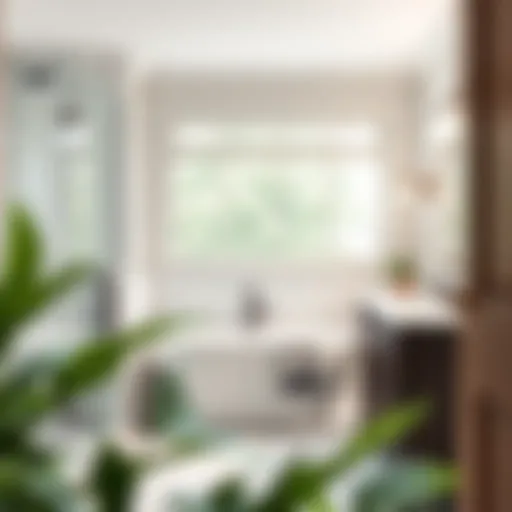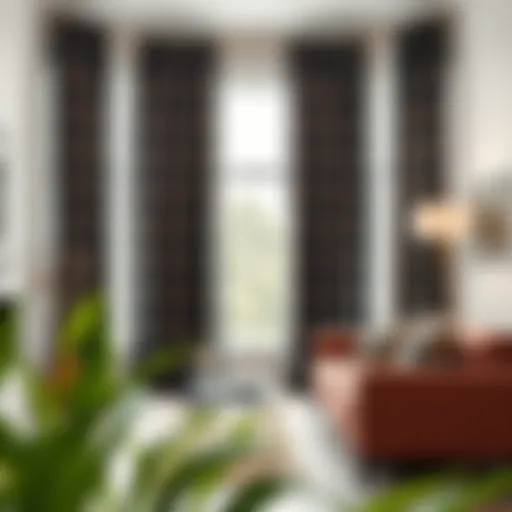Exploring the Unfinished Buffet in Modern Design


Intro
In the realm of home decor, the term "unfinished buffet" might not immediately evoke images of comfortable gatherings around a well-set table, but that’s where the charm truly lies. An unfinished buffet is not merely a piece of furniture; it serves as a narrative thread weaving together personal style, functionality, and the ever-evolving concept of what home means. It is a testament to the idea that sometimes, things left a little raw and unrefined can offer a unique aesthetic that resonates deeply with individual tastes.
This article unfolds the nuanced significance of unfinished buffets, exploring how they challenge conventional furniture narratives. A closer look reveals their role in turning spaces into intimate dining environments while simultaneously serving practical needs. Through this exploration, we will delve into design insights, and habits surrounding maintenance and care that keep these pieces not only aesthetically appealing but also functional for years to come.
Furniture Design Insights
Understanding Style Preferences
The allure of an unfinished buffet lies in its versatility. It's a canvas, inviting homeowners to inject their personality into a space. Whether your home leans towards rustic charm or a sleek modern vibe, the unfinished buffet can adapt accordingly. Designers often note how this adaptability extends beyond functional use into emotional connection, making each piece a story waiting to be told.
For instance, consider the raw wood finish; it bears the marks of its journey, each knot and hastily sanded area narrating a tale that speaks to authenticity. On the flip side, an unfinished buffet in a high-gloss lacquer brings forth sleek modernity, creating a striking contrast in traditional settings. The challenges for designers include harmonizing these pieces with the surrounding decor while ensuring they fulfill their intended roles.
Maximizing Space with Smart Layouts
Effective layout design is crucial, especially in smaller spaces where every inch counts. An unfinished buffet can serve multiple purposes, finding its place not only in dining areas but also as a stylish storage solution for linens or an eye-catching feature in entryways.
To maximize space, homeowners can:
- Position the buffet against a wall to free up central space for movement.
- Incorporate open shelving on top to showcase decorative items while utilizing the base for storage.
- Pair with seating options to create a cozy nook for casual dining or reading.
When the layout feels intentional, the unfinished buffet becomes not just a functional item but a key player in your living space.
Maintenance and Care Tips
Cleaning Techniques for Different Materials
While the rugged charm of unfinished buffets is appealing, they require appropriate care to maintain their visual allure. The approach you'll take depends on the materials used. For natural wood finishes, a gentle wipe-down with a damp cloth is often sufficient to remove daily dust and grime. Here are a few pointers:
- For wood: Avoid harsh cleaners; instead, use a mild soap solution followed by a soft cloth to preserve the finish.
- For metal accents: These can be wiped using a mixture of vinegar and water, ensuring the integrity of surfaces is kept intact.
- Avoid direct sunlight on any finishes to prevent fading.
Preventative Measures Against Wear and Tear
Preventing wear and tear is crucial for longevity. Here are some strategies:
- Use coasters for beverages, preventing rings and stains from forming on the surface.
- Implement regular dusting routines, using soft cloths to prevent scratching.
- Periodically check joints and hinges for any signs of loosening, addressing minor repairs before they escalate into larger issues.
Adopting these habits creates a nurturing environment for your unfinished buffet, allowing it to mature gracefully in tandem with your home.
"A well-cared-for piece of furniture will age like wine, becoming richer and more valued over time."
In sum, unfinished buffets hold a mirror to our personal aesthetics while being functional pieces in our homes. By embracing their simplicity and understanding their potential, we can curate dining experiences and living environments that are not only beautiful but also meaningful.
What Defines an Unfinished Buffet
Understanding what encapsulates the idea of an unfinished buffet is pivotal to grasping the nuances of contemporary furniture design. An unfinished buffet is not merely a piece of furniture; it’s a reflection of choices—both aesthetic and functional—shaped by a user’s personal tastes and lifestyle needs. Such pieces carry an inherent flexibility, allowing for a variety of finishing techniques that can be applied based on individual preference. This aspect alone makes the unfinished buffet a significant subject worth analyzing.
The characteristics of an unfinished buffet include its raw materiality, which can often appeal to individuals seeking a connection to nature through home decor. Not having a glossy finish lays bare the true provenance of the wood, allowing wood grain to tell its own story. The organic imperfections present in the material can evoke a sense of warmth and authenticity that finished alternatives might lack.
Additionally, unfinished buffets facilitate customization on a level that traditional furniture does not. Homeowners and designers often relish the opportunity to infuse their personality into these pieces. The freedom to choose finishing methods such as staining, painting, or even leaving it bare, provides a unique way to harmonize the buffet with surrounding decor.
Several factors can influence one's decision to select an unfinished buffet:
- Cost-Effectiveness: Often, unfinished pieces come at a lower price point, making them accessible for various budgets.
- Creative Opportunities: For DIY enthusiasts, these buffets serve as a blank canvas ripe for experimentation.
- Sustainable Appeal: With modern trends leaning towards sustainability, an unfinished buffet can be crafted from reclaimed or eco-friendly materials, further enhancing its appeal.
Overall, the unfinished buffet represents a convergence of beauty, practicality, and individual expression, making it a compelling furniture option for modern homes.
Material Choices and Construction Techniques
When it comes to constructing an unfinished buffet, material selection is critical. Most commonly, hardwoods like oak, maple, and walnut are favored for their durability and aesthetic qualities. This choice is often motivated by a desire for longevity—a significant consideration that aligns with sustainable design philosophies. Each type of wood brings a different character:
- Oak: Known for its strength and grain variation, oak finishes beautifully and develops character over time.
- Maple: Lighter in color, maple can deliver a clean and fresh look, making it a great option for modern styles.
- Walnut: Offers rich tones and a refined feel, which can elevate any space.
The construction techniques also play a vital role in defining the quality and functionality of the buffet. Mortise and tenon joinery, for example, provides superior strength and longevity compared to simpler techniques. Moreover, paying close attention to detail in the assembly process often results in a more robust and appealing end product.
Aesthetic Characteristics
The aesthetic allure of an unfinished buffet lies not just in the wood itself but also in its ability to fit various design styles. From rustic farmhouse to contemporary minimalism, these pieces can adapt seamlessly into diverse environments. The natural, untamed elegance of the wood can serve as a stunning focal point or work cohesively with other elements in a room.
Among the aesthetic features that can be highlighted:
- Natural Patterns and Textures: Each buffet showcases the unique markings, knots, and grains of the wood, telling a story that mass-produced furniture simply cannot replicate.
- Color Variability: The unfinished state allows for a spectrum of hues that can be further enhanced through bespoke finishing techniques—transcending from light, airy shades to deep, moody finishes.
In many ways, an unfinished buffet challenges conventional notions of what constitutes beautiful furniture. It evokes a deeper connection to craftsmanship and authenticity.
By understanding these defining elements, it becomes clear why unfinished buffets hold a unique place in furniture design. They are not just vessels for storage but also canvases for expression, highlighting the interplay between nature and human creativity.
Historical Context of Buffets in Furniture Design
Understanding the historical context of buffets is pivotal when analyzing their role in furniture design, especially their unfinished versions. Buffets symbolize not just utility but also cultural evolution and aesthetic evolution. In the grand tapestry of design, buffets have transitioned from essentials in royal banquets to fixtures in contemporary dining spaces, each phase reflecting societal changes. This section dives into how buffets have morphed over the ages, revealing their significance beyond mere functionality.
Evolution of Buffets Through Time
The journey of the buffet is as vibrant as the materials it’s crafted from. Originating in the Middle Ages, buffets were basic, practical pieces used primarily for serving food. Back then, it was often a table where food was laid out for guests, a rather straightforward affair. However, as we rolled into the Renaissance, the concept of what constituted a buffet expanded.
- Renaissance Influence: Furniture became more ornate, being influenced by art and culture. Buffets featured intricate carvings and served as a display of status. It wasn't just about function anymore; it became about appearance, signaling wealth and sophistication.
- Industrial Revolution: Fast forward a few centuries, makers adopted new materials and techniques, which transformed buffets into sturdier pieces adorned with glass and metal. This made them more accessible to the middle class, reflecting a shift in societal dynamics.
- Modern Era: Today, unfinished buffets stand as both a nod to tradition and an invitation for personalization. They allow homeowners to connect with a piece on a deeper level, offering a canvas for self-expression that’s rare in mass-produced furniture. Unfinished buffets represent not just a step backward to craftsmanship but also forward into individual creativity.
Cultural Influences on Buffet Styles
Buffets aren’t just products of their craft; they embody cultural influences that shape their design and usage. Different cultures have adopted the buffet concept, adding layers to its identity:
- European Tradition: In European countries, especially France and Italy, buffets carry historical significance from lavish feasts to contemporary dining experiences. The French buffet became known for its elaborate designs and serving methods, often incorporating rich textiles and elegant ceramics.
- Asian Influences: In contrast, Asian cultures accentual simplicity and function over extravagance. The use of bamboo and lacquer reflects an appreciation for natural elements and aesthetics. Japanese designs focus on clean lines and natural finishes, leaning towards a minimalist style that resonates with their cultural heritage.
- American Adaptations: In the United States, buffets were embraced as symbols of home and hospitality, reflecting a melting pot of global influences. Throughout the years, the American style evolved, often absorbing elements from various cultures, presenting a unique blend of traditions through unfinished to finished versions.
"Buffets are not merely furniture; they are expressions of culture, history, and individual storytelling. Every piece tells a story that connects past with present."
As we explore the historical context of buffets in furniture design, it becomes clear that these pieces are a confluence of utility and artistry, deeply intertwined with societal evolution. Understanding their journey over time not only highlights the significance of unfinished buffets but also enhances our appreciation for their role in modern interiors. The interplay of history and culture provides a rich tapestry that continues to influence how buffets are designed and utilized in homes today.


Functional Aspects of Unfinished Buffets
When it comes to furniture, the functional aspects are as vital as the aesthetics. An unfinished buffet offers both utility and style. It's more than just a hunk of wood; it embodies an essence of versatility. In today's fast-paced world, having furniture that meets various needs is essential. An unfinished buffet stands as a significant player in any dining space or even in other areas of the home. Let's explore how these pieces fulfill practical roles without compromising on design.
Storage Solutions in Dining Spaces
One of the most striking features of unfinished buffets is their ability to provide ample storage. Unlike traditional cabinets, these structures often boast open shelves, drawers, and compartments that can be customized. They can hold everything from dinnerware to linens, and even seasonal decorations. Their adaptability to one’s needs makes them advantageous. For instance, you might use the bottom shelves to store large serving platters while stashing away unused cookware in drawers above.
- Accessibility: Without heavy adornments or finishes, you can find what you're looking for swiftly. It's just plain practical.
- Layered Layouts: Unfinished buffets can create a layered look when combined with other furniture or decor items. Because they often come in natural shades, they allow for easy integration into various color schemes.
- Organized Spaces: Often, people struggle to keep their dining areas organized. An unfinished buffet can become the nucleus of this organization, containing everything in one location.
"In any dining space, the buffet serves as the heartbeat, handsomely storing items whilst showcasing personal flair."
Unfinished buffets reinstate the notion that beauty lies in functionality. With a bit of creativity, they can be transformed into magnet pieces in your dining area, effortlessly accommodating the plethora of items often found in meals or gatherings.
Versatility in Home Decor
Beyond the dining room, the charm of unfinished buffets is their ability to fit into various settings. They can enhance a living room, function as a console table in a hallway, or even be utilized as a makeshift bar in a cozy corner. This kind of multifunctional appeal can be crucial for homeowners looking to optimize every square inch of their dwelling.
- Transitional Spaces: An unfinished buffet draws attention without assertion. It can transition seamlessly between spaces, fitting in whether it’s styled traditionally or with a modern twist.
- Blank Canvas: Because they often come devoid of color and finish, these pieces serve as blank canvases for those who enjoy personalizing their interiors. A homeowner could slap on a coat of teal or white, or even leave it rustic, reflecting the owner's unique style.
- Showcasing Personal Ken: Place plants, family photos, or books atop your buffet. Each item tells a story, contributing to the overall ambiance of the room.
In summary, the functional aspects of unfinished buffets testify to their role as not only furniture but also as centers of activity and expression. Their storage capabilities offer solutions to practical needs while their versatility invites endless creative possibilities in home decor. Embracing these pieces allows homeowners and decorators alike to cultivate environments filled with functionality and personal flair.
The Role of Unfinished Buffets in Modern Interiors
When discussing interior design, unfinished buffets often play a pivotal role in establishing a distinctive atmosphere. Unlike traditional, polished furnishings, these pieces embrace raw aesthetics that resonate with a growing desire for authenticity in home spaces. They serve not just as furniture, but as statements that encourage creativity and personalization, allowing homeowners to craft environments that are uniquely their own.
Integration with Contemporary Design Trends
In today's world, design is continuously evolving. Unfinished buffets offer a seamless integration with various contemporary design trends. They are often seen as versatile pieces that complement multiple styles, from industrial to bohemian. The appeal lies in their ability to harmonize with other materials, such as metals or glass, without competing for attention. An unfinished buffet can effortlessly anchor a room, providing a rustic charm that softens harder design elements.
Homeowners increasingly gravitate towards open spaces. Thus, the flexibility that comes with unfinished buffets allows for effective utilization of areas that might otherwise appear empty or lifeless. Consider how a simple, unfinished wooden buffet can serve as a base for a vibrant display of artisanal ceramics or as a backdrop for lush greenery. Its inherent characteristics effortlessly adapt to the homeowner's vision, making it a go-to choice in modern interiors.
"Incorporating an unfinished buffet into your design can radically redefine a space, making it feel lived-in and inviting."
Combining Minimalism with Rustic Aesthetics
The minimalistic trend, marked by clean lines and a limited color palette, has taken the design world by storm. Unfinished buffets, with their simple forms and organic textures, embody this ethos splendidly while complementing rustic aesthetics.
Homeowners can achieve a balance between sleek minimalism and cozy warmth by placing unadorned buffets in their spaces. Imagine an expansive white wall paired with a rich, milky oak buffet, offering a friendly contrast. This juxtaposition encourages an inviting feel, inviting guests to linger and enjoy their surroundings.
Moreover, the beauty of unfinished wood lies in its natural imperfections. Each scratch or mark reflects a story, adding a layer of character that polished surfaces often lack. This ability to merge the modern principles of simplicity with the timeless appeal of rustic charm makes unfinished buffets an exceptional choice for those who appreciate thoughtful design.
Personalization: The Art of Finishing Your Buffet
When it comes to unfinished buffets, personalization stands as a key area of focus, turning these mere pieces of wood into extensions of one’s home and personality. The allure of an unfinished buffet lies in its potential to become something uniquely yours. Homeowners, designers, and DIY enthusiasts alike find that customizing the finish not only enhances the aesthetic appeal but also offers a sense of pride and accomplishment. After all, who doesn’t want their furniture telling a story?
Choosing the Right Finishing Techniques
Selecting an appropriate finishing technique is pivotal in the transformation journey of an unfinished buffet. Several factors come into play here, including the intended use of the buffet, the existing decor, and personal taste. Here’s what to consider:
- Material of the Buffet: Different woods react in unique ways to finishes. For instance, oak holds stain well, while pine may absorb it unevenly. Understanding wood characteristics is crucial for a lasting finish.
- Usability and Exposure: If the buffet will be placed in a high-traffic area or used frequently for dining, opting for a more durable finish like polycrylic varnish would be wise. This offers protection against scratches and stains.
- Time Commitment: Some techniques, such as layering stains or paints for depth, can be time-consuming. If time is of the essence, simpler methods might be preferable.
Taking these elements into account will help ensure that the final product not only complements your space but withstands the rigors of everyday use.
Using Paint, Stain, and Varnish
The trio of paint, stain, and varnish embodies the essence of finishing your buffet. Each brings something distinct to the table—literally and figuratively.
- Paint: This is often favored for its versatility. From bold colors to soft pastels, paint allows for immense creativity. You can create striking contrasts or plush monochromatic views. One technique gaining traction is the use of chalk paint, which imparts an appealing matte finish. Just be mindful that paint may chip over time, so layer a varnish on top for protection.
- Stain: It serves as a means to showcase the natural beauty of the wood. A stain can enhance grain patterns, allowing those unique characteristics to shine. Many prefer it for rustic or farmhouse styles, as it integrates beautifully with various textures. It’s worth noting the different types available—oil-based tends to penetrate deeply while water-based offers quicker drying times and a less toxic application process.
- Varnish: Often the unsung hero, varnish provides a protective layer, preserving the wood underneath. It comes in various finishes—from glossy to matte—enabling you to achieve that desired sheen. When applied correctly, varnish can enhance colors and safeguard against moisture and wear.
"A well-finished buffet is not just furniture; it’s a part of the family narrative."
In summary, the art of finishing your buffet is not just about aesthetics; it’s about expressing who you are and what your home represents. By carefully selecting your finishing techniques—paint, stain, or varnish—you not only elevate the buffet’s beauty but also ensure its longevity. With every brush stroke or spray, you invest in making a piece of furniture that reflects your personal touch.
Maintaining and Caring for Unfinished Buffets
Taking care of an unfinished buffet is not just about ensuring its durability, but also preserving the potential it holds for personalization and character. For many homeowners and designers, these pieces symbolize a blend of rustic charm and practical utility. Understanding how to maintain and care for these types of buffets can elevate their longevity, appeal, and functional use in home design.
Preserving Natural Wood Finishes
The allure of natural wood is often found in its grain patterns and textures, which tell a story about the tree it came from. Preserving this natural finish requires a careful hand, as improper maintenance can lead to fading or damage. Here are some key considerations:
- Avoid harsh chemicals: Stick to mild cleaning solutions that do not strip natural oils or finishes.
- Use natural products: A simple mix of olive oil and vinegar can work wonders as a polish. Just be careful with the ratios; too much vinegar can be corrosive.
- Protect from direct sunlight: Leaving your buffet in bright sunlight can bleach the wood over time. Using curtains or moving the piece to a shaded area can help.
- Humidity levels: Wood reacts to moisture in the air. Keeping the humidity consistent helps maintain the integrity of the wood, ideally between 40% and 60%.
Maintaining your unfinished buffet is like tending a garden; it requires nurturing and attention to detail.
Cleaning and Upkeep Tips
Cleaning an unfinished buffet doesn’t have to be a tedious task. In fact, there are simple practices you can adopt to keep it looking fresh and inviting. Here are some reliable tips:
- Dust Regularly: Dust accumulation can scratch the surface if not managed. A soft microfiber cloth is ideal for gently wiping away dust without damaging the wood.
- Use a Soft Cloth for Cleaning: When spills happen—it’s a buffet after all!—use a slightly damp cloth to wipe them clean. Dry immediately to avoid water marks or potential warping.
- Avoid Excessive Water: Too much water can seep into the wood and cause damage. Instead of soaking the cloth, it's better to dampen it lightly.
- Regular Polishing: A light polish every few months helps maintain that attractive shine while protecting the wood from daily wear and tear.
- Consider Waxing: Applying a wax finish can provide another layer of protection while also enhancing the beauty of the wood grain. Choose a high-quality natural wax for best results.
By integrating these maintenance practices into your routine, the character and functionality of your unfinished buffet will remain intact, offering both utility and artistic expression in any home environment.
Comparative Analysis: Finished vs. Unfinished Buffets
The exploration of the comparative analysis between finished and unfinished buffets serves as a pivotal aspect of this discourse, illuminating the nuanced differences that shape consumer choices and design preferences. Understanding these distinctions can greatly influence homeowners, designers, and retailers alike as they navigate the bustling realm of furniture selection.
Practical Benefits of Unfinished Buffets
Unfinished buffets boast a variety of practical advantages that often lead individuals to prioritize them over their finished counterparts. Here are some compelling reasons why these pieces may capture one's interest:
- Customization Potential: One of the most alluring aspects of unfinished buffets is their inherent adaptability. Homeowners can choose their finish, whether opting for natural wood, a vibrant paint color, or a specific stain. This flexibility allows for a seamless integration into existing decor, which can be a game changer for those with precise aesthetic sensibilities.
- Cost-Efficiency: Generally, unfinished furniture tends to carry a more wallet-friendly price tag than its fully polished peers. The cost savings can be significant, especially for DIY enthusiasts eager to take on personalization projects without breaking the bank.
- Eco-Friendly Choices: The growing trend towards sustainable living has made unfinished buffets appealing to environmentally conscious consumers. When opting for unfinished wood, buyers often have the opportunity to select sustainably sourced materials, reducing their carbon footprint compared to mass-produced finished options.
"Investing in unfinished furnishings isn’t just about the product; it's a statement about values and individuality."
In many cases, the practical benefits of these buffers extend beyond just functionality, allowing for a deeper connection to the items that populate homes.
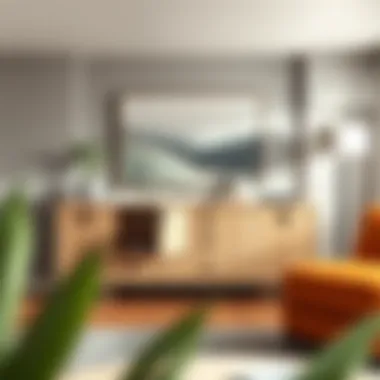
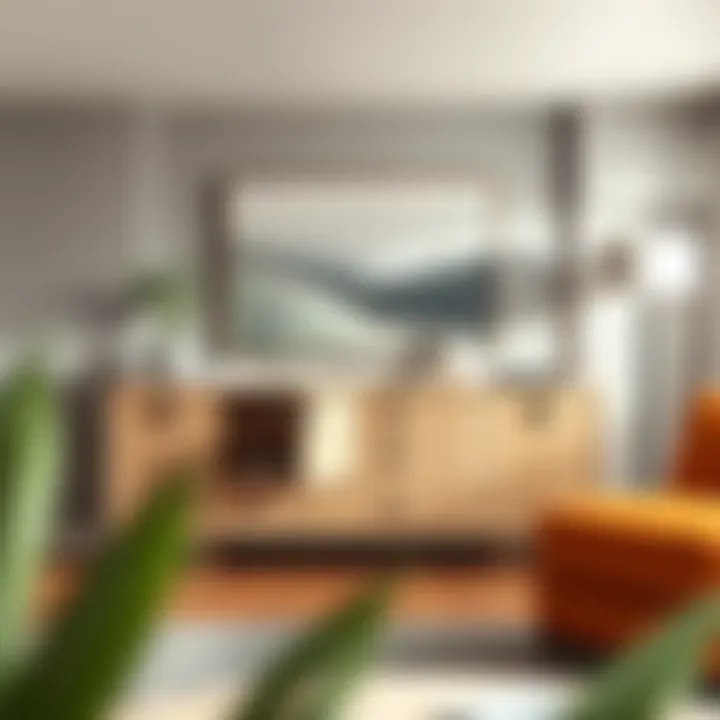
Aesthetic Differences That Matter
Aesthetic appeal varies significantly between finished and unfinished buffets, and these differences deserve careful consideration. For many, the look of a piece is as crucial as its practical aspects. In this light, the unfinished buffet presents a certain charm:
- Raw Authenticity: Unfinished buffets provide an invitation to the raw beauty of natural wood grain and texture. This unrefined quality appeals to many as it brings an organic warmth into living spaces. In contrast, finished buffets can sometimes seem too polished and sterile, lacking the character that imperfections can imbue.
- Versatility in Design Styles: While finished pieces usually adhere to specific design trends, unfinished buffets can fit seamlessly into various settings, be it traditional, rustic, or contemporary. This makes them popular among those seeking a blend of styles.
In assessing these aesthetic differences, it becomes evident that individual taste plays a significant role. The choice between a finished or an unfinished buffet often boils down to personal preference and environmental considerations.
To conclude, distinguishing between finished and unfinished buffets highlights practical benefits and aesthetic values that resonate with diverse audiences. Such thoughtful comparisons not only enhance consumer knowledge but foster an appreciation for the artistry involved in furniture design.
Trends Shaping the Future of Buffets
Understanding trends in furniture design is crucial for anyone involved in creating, selling, or purchasing a buffet. The growing interest in how unfinished buffets fit within broader design trends offers insights into their practical and aesthetic potential. With a shift towards sustainability and personalization, the landscape is changing dramatically. This section examines the environmental principles and innovative materials shaping the future of buffets, signaling their importance in defining modern interior spaces.
Sustainable Practices in Furniture Design
Sustainability isn't just a buzzword; it's becoming a non-negotiable aspect of furniture design, especially for items like buffets that often play a central role in home decor. More people are now drawn to eco-friendly products, and this has a tangible impact on the way unfinished buffets are crafted and marketed. Rather than relying on materials detrimental to the environment, many manufacturers are pivoting to reclaimed wood, bamboo, and other renewable resources.
Using sustainable materials not only provides a clearer conscience for consumers but also connects them with the natural world in their living spaces. It is vital for decorators and designers to recognize that by selecting these materials, they also fulfill a growing market demand for responsible sourcing. The choice to utilize finishes made from non-toxic stains and glues adds a layer of safety, making these items perfect for homes with children or pets.
"The crafting of furniture with sustainability in mind reshapes not just homes, but the industry itself."
The move to sustainability doesn't come without its share of challenges, though. There are constant discussions around maintaining quality and durability while being environmentally conscious. Nonetheless, advances in technology are beginning to meet these demands, allowing for the production of high-quality, sustainable furnishings that can stand the test of time.
Innovations in Materials and Style
When it comes to unfinished buffets, creativity knows no bounds. The future of buffets lies heavily in the development of innovative materials that can push the boundaries of design. Designers are now experimenting with composite materials that blend wood with resins, creating a unique look while ensuring sturdiness and longevity. Meanwhile, the rise of artistic surfaces – think of textured finishes or mixed media – allows for personal expression, contributing to the allure of unfinished buffets.
In addition to materials, the styles of buffets have evolved, adapting to the preferences of a new generation of homeowners and renters. Mid-century designs, Scandinavian minimalism, and even industrial aesthetics are being reinterpreted with modern sensibilities. Integrating sleek lines with rustic finishes caters to a wide array of tastes.
Utilizing 3D printing technology is another frontier in buffet design. This method can lead to intricate designs and customization possibilities that traditional woodworking methods may not deliver. The flexibility of this technology allows designers to create pieces that perfectly fit specific spaces and meet individual needs. Plus, it can significantly reduce waste during the manufacturing process.
As these innovations continue to develop, they promise to reshape not only the unfinished buffet but also the broader scope of furniture design. It's clear that unfinished buffets are poised to adapt and evolve alongside these trends, presenting opportunities for both makers and consumers who seek to merge functionality with deeply personal aesthetics.
Setting the Mood: Buffets in Social Spaces
Creating an inviting atmosphere is an art in itself, and the buffet truly plays a pivotal role in this endeavor, especially during social gatherings. Buffets serve as more than just furniture; they act as a central hub that facilitates interaction, nourishment, and set the tone for memorable interactions among family and friends. By positioning a buffet thoughtfully, one can enhance the overall mood of a dining space, allowing guests to feel at ease and welcome.
Creating Inviting Dining Environments
When it comes to designing a dining area, the inclusion of an unfinished buffet can make all the difference in creating an inviting environment. These unadorned and natural pieces allow the wood's grain to shine, lending an organic charm that can be both rustic and elegant. Moreover, when adorned with select decor – think a quaint vase of fresh flowers or a neatly arranged stack of artisanal bread – the buffet becomes a focal point that draws the eye and encourages guests to gather round.
- Layered Textures: Using different materials such as soft cloths and polished wood together creates depth.
- Personal Touches: Adding family heirlooms or personal artifacts on or near the buffet showcases one’s personal history and warms up the space.
- Mood Lighting: Pairing the buffet with subtle lighting, like candles or string lights, invites relaxation and casual conversation.
The buffet’s positioning is equally important. A well-placed buffet can offer easy access to food and drink without interrupting the flow of conversation, allowing guests to feel at home, as they serve themselves. This self-service style reduces the pressure often felt during formal dinners, promoting a more relaxed vibe.
The Role of Buffets in Hosting Events
During hosting duties, the buffet essentially becomes the unsung hero. It is not merely a functional piece; it embodies hospitality itself. The buffet invites guests to help themselves, creating a sense of autonomy and engagement. Especially during larger gatherings, such as family reunions or festive celebrations, it acts as a practical solution to serve food without the formality of a sit-down dinner. Guests can come and go as they please, socializing and mingling at their own pace.
In an age where personal expression is vital in home decor, an unfinished buffet can be uniquely customized according to the season or occasion.
- Seasonal Themes: For instance, one might top the buffet with pumpkins and autumn leaves in the fall, or fresh greens and flowers in spring.
- Customized Serving Styles: One can incorporate charcuterie boards, buffet-style pasta bars, or even dessert stations, making it a versatile piece that adapts to various culinary styles.
- Cultural Representations: For events that celebrate a particular culture, the buffet can be decorated with symbols or elements reflective of that heritage, enriching the dining experience further.
User Experiences: The Pleasure of Using Unfinished Buffets
When we talk about unfinished buffets, we're not just discussing a piece of furniture; we’re delving into a world of personal expression and functionality. These buffets serve as blank canvases, providing users the pleasure of making something uniquely theirs. In homes that prioritize individuality and creativity in decor, unfinished buffets fit right in, allowing for various designs and adaptations.
Real-Life Applications in Various Settings
Unfinished buffets are like chameleons, adapting to different environments and uses. For instance, in a cozy dining room, a well-crafted unfinished buffet can serve as a focal point, holding not just dining essentials but also showcasing collectors’ items or family heirlooms.
- Home Dining Area: Here, the buffet can provide both storage and serve as a serving station for family meals, making it easy to set the table or display dishes during gatherings.
- Entryway Use: Some homeowners creatively repurpose these buffets as entryway tables. They can serve as a spot for keys and bags, combining practicality with rustic charm.
- Craft Rooms: In artistic spaces, unfinished buffets play a crucial role. They can store supplies while allowing crafters to personalize every detail, turning storage into an artistic statement.
These real-life applications demonstrate the versatility of unfinished buffets. They fit into whatever setting you choose, adapting to your needs while enhancing the aesthetic.
Testimonies from Homeowners
Homeowners often share their experiences with unfinished buffets, and the stories speak volumes about the joy these pieces bring. One particular homeowner, Sarah, reflects on her choice of an unfinished oak buffet in her dining room:
"I love that I could paint it myself and let it reflect my personality. Every time I walk past it, I feel a sense of pride knowing I contributed to my home in a very personal way. The imperfections in the wood tell stories, and I enjoy being part of its journey."
Another homeowner, John, mentions his use in a home office: "Using an unfinished buffet allows me to organize my supplies without sacrificing style. I can utilize it as a workspace while adding personal touches, like family photos or art pieces. It really brings warmth to the room."
These testimonials aren’t just touching anecdotes; they highlight the significance of unfinished buffets in crafting spaces that resonate with users’ identities. The pleasure of these experiences comes not merely from practical use but from their potential for creativity, personalization, and emotional connection.
Exploring Aesthetic Choices: Color and Texture
The discussion around unfinished buffets isn’t just about functionality; it includes a rich tapestry of aesthetic choices related to color and texture. These elements are pivotal in defining the character of any piece of furniture, especially buffets, which often become the centerpiece in both dining areas and social gatherings. Exploring aesthetic choices guides both the homeowner and the designer in generating a harmonious environment that reflects personal style while remaining practical. Emphasizing the significance of color and texture can transform a simple unfinished buffet into a statement piece that enhances the overall decor of a home.
Natural Finishes: Appealing to the Eye
Natural finishes on unfinished buffets offer unique beauty and warmth, drawing attention through their simplicity. They can range from the raw luminosity of oak to the deep, rich hues of walnut. The appeal lies not only in the varying visual aspects but also in the tactile experience they provide—there’s something inherently satisfying about the feel of wood graining under one's fingers.
When one opts for a natural finish, it’s essential to consider the wood's inherent characteristics. For instance, cherry wood develops a beautiful patina over time, creating an inviting atmosphere that grows richer with age. This layering of color adds depth, fostering an environment that feels alive rather than static.
Moreover, maintaining an embrace of natural finishes often aligns well with trends towards sustainability and eco-conscious living. As homeowners become increasingly aware of their environmental footprint, choosing unfinished pieces allows them to endorse natural aesthetics without compromising their values.
Here are some benefits of opting for natural finishes:
- Authenticity: They showcase the true nature of the wood, imparting a sense of honesty in design.
- Versatility: Works well with various styles, be it rustic, contemporary, or classic.
- Easy maintenance: Typically easier to refresh or reapply than highly processed finishes.
Natural finishes aren't just a style choice—they represent a mindful decision in furniture selection that resonates with both beauty and sustainability.
Incorporating Textural Variety
Texture plays a crucial role in creating a multi-dimensional feel in a room, and when it comes to unfinished buffets, the introduction of different textures can create visual interest and enhance the overall sensory experience. Textural variety can be achieved through various methods, such as mixing different wood types, adding metal accents, or even including woven materials like rattan.


For instance, consider a buffet that combines a smooth walnut surface with distressed iron hardware. This juxtaposition not only creates a visual feast but invites touch and interaction, making the buffet more than just furniture—it becomes an engaging aspect of home decor.
Incorporating different textures provides a welcome contrast that can address various aesthetic preferences. For instance, if a home leans toward a more minimalist design, the inclusion of a lightly textured finish can soften the starkness and add warmth without overwhelming the simplicity of the space.
Here are some ideas for introducing textural variety into a buffet:
- Combine Smooth and Rough Surfaces: Use a sleek finish for the main structure contrasted with a rustic top or shelving.
- Mix Materials: Integrate elements like ceramic dishes or glassware on the buffet, offering contrasting materials that draw the eye.
- Layer it Up: Include decor items of varying textures, such as woven baskets, textured table runners, or ceramic vases, to enhance the buffet's visual appeal.
Design Considerations for Space Planning
When it comes to incorporating an unfinished buffet into your home, a well-thought-out space plan is critical. It's not just about plopping a piece down wherever it seems to fit; it’s about crafting a harmonious environment that enhances both functionality and aesthetics. A buffet can serve as a centerpiece, a boundary marker, or simply a practical storage solution, depending on how you approach its placement and integration into your decor.
Sizing and Proportions in Room Layouts
Getting the size and proportion right for your buffet is more important than one might think. It’s like finding the right key for a lock; an incorrect fit can throw off the entire design.
- Understanding Scale: In smaller spaces, a compact buffet will avoid overwhelming the room. Conversely, larger spaces might benefit from an expansive buffet that can accommodate family gatherings or entertaining guests.
- Visual Weight and Height: A buffet that is too tall or wide can clash with surrounding furniture, making the room feel cramped. On the other hand, a buffet that is too petite might vanish against a backdrop of larger items.
- Room Flow: Think about how people will move around the space. You want to avoid creating obstacles while also making sure that the buffet is accessible. This involves planning for adequate clearance zones around the buffet; a good rule of thumb is to leave at least 36 inches for pathways to ensure smooth traffic flow.
Positioning Buffets for Optimal Impact
Positioning your buffet effectively can make all the difference. It's not just where you place it, but how it interacts with the rest of the room. A well-placed buffet can elevate the entire atmosphere of your dining area or living space.
- Focal Points: Think about what draws the eye when someone enters the room. Positioning the buffet against a visually appealing wall or near windows can create a sense of depth. This arrangement not only highlights the buffet itself but adds layers of interest to your decor.
- Purpose-Oriented Placement: If the buffet serves a dual purpose, such as a serving table during gatherings, situate it closer to your dining table, or make sure it’s easy to access from the kitchen.
- Complement Existing Decor: A buffet isn’t an island; it should complement or contrast with other elements around it. For example, if things are leaning towards industrial aesthetics, a reclaimed wood buffet would blend in beautifully, while ensuring contrast with sleek, modern pieces.
Effective space planning is akin to composing a symphony; each piece needs to harmonize with others for the overall beauty to shine through.
In summary, thoughtful planning regarding size, proportion, and placement of an unfinished buffet enables homeowners to maximize its utility and charm. Navigating these design considerations effectively ensures that your buffet does more than just occupy space; it becomes an integral part of your home’s narrative.
DIY Unfinished Buffets: A Custom Approach
Creating an unfinished buffet allows for a personalized touch that finished pieces simply can't replicate. It provides homeowners and enthusiasts a unique opportunity to channel creativity, ensuring that each piece resonates with their individual style. This freedom of expression is a significant draw in today’s world of standardization, where mass-produced furniture often lacks character. Engaging in a DIY project isn’t just about saving money; it’s also about making a statement in your home environment.
When we talk about DIY unfinished buffets, we delve into not just the aesthetic appeal but also the functional advantages they present. With the right approach, an unfinished buffet can transform a mundane dining area into a sanctuary of personal stories and shared meals. Fostering a cozy atmosphere encourages social interaction, and a custom buffet serves as the perfect backdrop for these moments.
Step-by-Step Guide to Creating Your Own
Crafting your own unfinished buffet can be an adventure. Here’s a straightforward guide to help you embark on this rewarding project:
- Select Your Materials: Choose natural woods like pine or oak, which are straightforward to work with and widely available. Consider the dimensions based on space.
- Planning the Design: Sketch a design that fits your vision and space constraints. Utilize online resources like Pinterest or Home Depot for inspiration.
- Gather Tools: Ensure you have the basic tools at hand: a saw, drill, sandpaper, and wood glue. If you plan on a more elaborate design, a jigsaw or router may also be beneficial.
- Assemble the Structure: Cut your wood and build the frame of the buffet. Secure joints with wood glue and screws, and be sure to double-check your measurements to avoid any misalignments.
- Sanding and Refining: Sand the surfaces to a smooth finish, removing any rough edges that could diminish its appeal.
- Final Touches: Leave the wood unfinished or apply a desired stain or varnish to enhance its natural grain. This is your opportunity to inject personal flair.
Budget-Friendly Tips for Beginners
DIY projects can be financially daunting but can also be an economical pursuit. Here are some tips to keep your costs in check:
- Repurpose Existing Furniture: Consider transforming old furniture into a new buffet to save on costs. Getting a piece from a thrift store or garage sale can conjure a unique and cherished item.
- Buy in Bulk: Purchase your materials from wholesalers or bulk suppliers. This can significantly reduce expenses, especially if you plan on making multiple units.
- DIY Finishes: Experiment with natural stains or homemade finishes, using items such as coffee grounds or vinegar with steel wool, which can make for cheaper alternatives.
- Borrow Tools: If you’re new to woodworking, before investing in a full set of tools, see if you can borrow from friends or local community groups. Community centers sometimes also offer workshops where you can use the tools for free.
"Crafting your own buffet is not merely about furniture; it’s about weaving your own narrative within your home.”
In summary, creating a DIY unfinished buffet presents an opportunity for self-expression, functional design, and economic savings. Engaging in such a project can instill pride in workmanship and enhance personal spaces in meaningful ways.
Cultural References and Symbolism of Buffets
In the realm of furniture design, buffets do more than serve a practical purpose. They hold cultural significance, reflecting societal values and norms. Across different eras and regions, the buffet has evolved from mere storage solutions to symbols of hospitality, artistry, and personal expression. A deeper exploration of these cultural references reveals how buffets transcend their utility, offering a canvas of creativity and tradition.
The Buffet as a Cultural Artifact
To view a buffet solely as a piece of furniture is to overlook its rich narrative as a cultural artifact. Historically, buffets have taken on multiple forms, each resonating with the ethos of its time. For example, consider the ornate buffets of the Victorian era, characterized by intricate carvings and dark woods. These pieces were not just functional; they were statements of wealth and status, often displayed in the grand dining rooms of the affluent.
Furthermore, buffets have transcended mere local craftsmanship. The influence of global styles can be observed, as seen in the integration of Asian motifs into Western designs or the Scandinavian minimalist approach which emphasizes function alongside beauty. Buffets tell stories of the cultural exchanges that happen over dinners and gatherings, melding different traditions and ideas into a single piece.
"In every smooth curve and subtle finish lies a tale of culture and tradition, making buffets much more than just surfaces for setting down plates."
In contemporary settings, the unfinished buffet stands as a symbol of authenticity. The raw wood appeals not only to aesthetic sensibilities but also evokes a sense of connection to nature, a nod to the sustainability ethos growing in modern design. This shifts the focus from seeking perfection in smooth finishes to appreciating the beauty in imperfections, capturing a cultural shift towards a more holistic approach to living spaces.
Symbolic Representation in Social Gatherings
The buffet occupies a vital role in social gatherings, acting as the heart of conviviality. In many cultures, the presence of a buffet signifies more than just a meal; it heralds community, connection, and celebration. When friends and family gather, the buffet serves as a backdrop for shared experiences, from festive celebrations to intimate dinners.
In a social setting, an unfinished buffet can be a gentle reminder of simplicity and home. It invites guests to draw closer, encouraging a sense of familiarity and warmth. Unlike polished, finished pieces that might feel more formal or intimidating, an unfinished buffet often feels approachable. The visible grains of the wood can inspire conversation, sparking discussions about crafting, materials, and even the philosophies behind choosing raw over refined.
Benefits of Understanding Buffets in Social Contexts:
- Cultural Bonding: Buffets reflect communal values, often representing shared heritage and traditions.
- Encouraging Interaction: The arrangement invites guests to serve themselves, fostering interaction and camaraderie.
- Symbolizing Abundance: An elegantly arranged buffet can denote hospitality, showcasing the care and effort put into hosting.
In essence, the buffet evolves into a powerful symbol that extends beyond its physical space. It embodies culinary tradition, social interaction, and artistic expression, all coming together to celebrate the act of gathering. The unfinished aspect plays its part too, grounding these lofty ideas in the realm of tangible experience, one that resonates deeply with hosts and guests alike.
Final Thoughts on the Unfinished Buffet Phenomenon
In wrapping up the discussion around unfinished buffets, it becomes apparent that these pieces are far more than mere storage solutions. An unfinished buffet embodies a philosophy that merges functionality, personal expression, and aesthetic appeal, challenging traditional furniture paradigms. Within the realm of interior design, they present an avenue for homeowners and designers to explore creativity while addressing practical needs. As we consider the varying elements that make up this topic, it's crucial to reflect on the significance of unfinished buffets and what they contribute to our living spaces.
Reflecting on Design Choices
The choice of an unfinished buffet allows individuals to make a striking statement in their homes. While finished buffets might showcase polished appearances, the unfinished alternatives invite the savvier homeowner to engage with their piece on a deeper level. Here, one isn’t just purchasing furniture; one is diving into a project that involves choice and personalization.
The beauty lies in the imperfections and the rawness of the unfinished wood. Each scratch, mark, or slight blemish tells its own story — a narrative of craftsmanship and authenticity that finished pieces can sometimes lack. This element of character invites a relationship between the user and the bufffet, encouraging a form of dialogue that is often lost in a mass-produced world.
Several design choices come into play when deciding the fate of such a buffet:
- Material Preference: Choices range from oak to pine, and the decision often reflects the wider ethos of sustainability and natural living.
- Finishing Touches: This can include various stains, paints, and varnishes that resonate with the homeowner's style, allowing them to tailor the experience.
- Positioning and Integration: How the buffet fits into the larger scheme of home decor adds another layer of consideration, affecting not only aesthetics but also functionality in spaces like dining rooms or kitchens.
The Future of Buffets in Home Decor
Looking towards the future, it's hard not to see the potential of unfinished buffets in the evolving landscape of home decor. As trends lean toward minimalism, the unfinished buffet stands as a unique bridge between modernity and rustic charm. Now more than ever, consumers are drawn to pieces that offer not just style, but also the flexibility of personal expression.
With the increasing awareness of environmental issues, unfinished buffets advocate for sustainability. By choosing these items, the average consumer makes a statement about their values — promoting reduced waste and preferring quality craftsmanship over mass production. The antique charm found in unfinished pieces resonates with a growing demographic that favors individuality over uniformity, positioning buffets not just as furniture, but as potential heirlooms that add historical context to any home.
Epilogue
To sum up, the unfinished buffet is more than just a functionally attractive piece; it’s a canvas of opportunity, creativity, and social consciousness. As we consider the many dimensions explored in this article, it becomes clear that unfinished buffets hold a significant place within the dialogue of modern interior design. From design choices that reflect personal style to their increasing potential as eco-friendly alternatives, these buffets will only grow in relevance in homes across the globe.
"In embracing the unfinished, we invite authenticity into our spaces, allowing our homes to tell a story that is uniquely ours."
The journey of incorporating an unfinished buffet into home decor is not only about aesthetics but about participating in a larger narrative of sustainability and personal expression.



